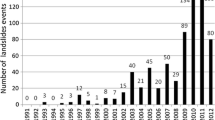Abstract
Most successful search and rescue is performed by neighbors and household members during the first 24 h after an earthquake, before professional responders arrive on the scene. Many spontaneous responders become casualties in the process. Kandilli Observatory and Earthquake Research Institute’s Disaster Preparedness Education Project with the support of the Earthquake Engineering Department has developed a training module for Community Disaster Responders to help them assess the level of damage for immediate citizen disaster response. Learning the signs of damage in both reinforced concrete and adobe buildings, they will be better able to distinguish the slight and moderately damaged buildings where their light search and rescue efforts will be effective, as opposed to the heavily damaged buildings where professional help is required for safe extrication. Incorporating citizens into the early stages of building collapse rescue is designed to make professional urban search and rescue efforts more effective. The program is being piloted in Turkey by the Civil Defense Directorate, Search and Rescue Brigade. It is expected that this will lead to a new demand for engineers to work in partnership with community-based organizations for planning and prioritizing disaster mitigation efforts, and to participate in immediate post-disaster damage assessment. Engineering recommendations will also be needed for post-earthquake building re-entry and re-habitation risk assessment.
Similar content being viewed by others
References
Applied Technology Council (1999) Earthquake Aftershocks – Entering Damaged Buildings, ATC Techbrief 2, Available: http://www.atcouncil.org
H.K. Armenian E.K. Noji A.P. Organessian (1992) ArticleTitleA case-control study of injuries arising from the earthquake in Armenia, 1988. Bull World Health Organisation. 70 IssueID2 251–257
A.W. Coburn R.J.S. Spence (1992) Earthquake Protection John Wiley & Sons Ltd Chichester
A.W. Coburn A. Pomonis S. Sakai (1989) Assessing strategies to reduce fatalities in earthquakes N.P. Jones (Eds) Proceedings, International Workshop on Earthquake Injury Epidemiology for Mitigation and Response MD Johns Hopkins University Baltimore 107–132
Collins, L. (2000) Los Angeles, From Turkey to Taiwan, www.iahep.org
M. Bruycker ParticleDe D. Greco M.F. Lechat (1985) ArticleTitleThe 1980 Earthquake in southern Italy: morbidity and mortality International Journal of Epidemiology. 14 IssueID1 Mar. 113–117
Durkin, M.E., Ohashi, H. (1989) Casualties, survival and entrapment in heavily damaged buildings. Paper presented at the Proceedings of the Ninth World Conference on Earthquake Engineering, Kyoto and Tokyo, Japan
Federal Emergency Management Agency (2004) Community Emergency Response Team (CERT) Training IS-137 Module 5: Search and Rescue Lesson 17: Introduction to Light Search and Rescue Self-Study Guide. Available: training.fema.gov/EMIWeb/downloads/is31717SearchandRescue.pdf (15.02.04)
Harkins, J., Collins, L., Petal, M. (2003) Community Disaster Volunteers 1- Curriculum, Bosphorus University, Disaster Preparedness Education Project, Istanbul, Turkey
INSARAG (2002) Collapsed Structure, Search and Rescue Course, http://www.reliefweb.int/insarag/ (14.02.2003) Structural Triage and the INSARAG Marking System
F. Krimgold (1990) Earthquake casualty estimation and response modeling N.P. Jones (Eds) Proceedings, International Workshop on Earthquake Injury Epidemiology for Mitigation and Response MD Johns Hopkins University Baltimore 54–59
Lechat, M.F. (1976, January 8, 1976) The Epidemiology of Disasters/ Epidemiology & Community Medicine. Paper presented at the Proceedings of the Royal Society of Medicine
D.M. McGuigan (2002) Urban Search and Rescue and the Role of the Engineer, Master hesis University of Canterbury Canterbury
National Institute of Occupational Safety and Health, NIOSH ALERT: January 1986 Request for Assistance in Preventing Occupational Fatalities in Confined Spaces, (NIOSH) Publication No. 86-110 http://www.cdc.gov/niosh/86110v2.html (14.02.2003)
E.K. Noji (1989) ArticleTitleThe 1988 earthquake in Soviet Armenia: implications for earthquake preparedness Disasters. 13 IssueID3 255–262
Noji, E.K. (1990) Epidemiologic studies from the 1988 Armenia earthquake implications for casualty modelling. In: Workshop on Modelling Earthquake Casualties for Planning and Response CA, VSP Associates & amp; California Emergency Medical Services Authority, Asilomar, pp. 37–64
Noji, E. (1997a) The epidemiology of earthquakes: implications for vulnerability reduction, mitigation and relief in World Health Organization. “Proceedings of the International Symposium on Earthquakes and People’s Health: Vulnerability Reduction, Preparedness and Rehabilitation”, Kobe, Japan 18 January 1997
E.K. Noji (1997b) Public Health Consequences of Disasters Oxford New York
E.K. Noji H.K. Armenian A. Oganessian (1993) ArticleTitleIssues of rescue and medical care following the 1988 Armenian earthquake International Journal of Epidemiology 22 IssueID6 Dec 1070–1076
Petal, M. (2003a) Research Report: Afyon (Sultandag>-Bolvadin) February 6th, 2002 9:03 a.m. 6.0Ms Earthquake Deaths and Injuries, Reconnaissance Study,Bogazici University, Disaster Preparedness Education Project, Istanbul, Turkey
Petal, M. (2003b) Research Report: Causes of Deaths and Injuries in the August 17th, 1999 3:02 a.m. Mw 7.4 Kocaeli Earthquake, Bogazici University, Disaster Preparedness Education Project, Istanbul, Turkey
M. Petal (2004) Urban Disaster Mitigation and Preparedness: The 1999 Kocaeli Earthquake, Doctoral dissertation, Department of Urban Planning University of California Los Angeles Los Angeles
Pomonis, A., Coburn, A.W., & Spence, R.J.S. (1992) Part three: casualty estimation in the collapse of reinforced concrete buildings. In: Human Casualties in Building Collapse – Second Year Report, Cambridge, pp. 33–45
Author information
Authors and Affiliations
Corresponding author
Rights and permissions
About this article
Cite this article
Petal, M.A., Celep, U., TüZün, C. et al. Teaching Structural Hazards Awareness for Preparedness and Community Response. Bull Earthquake Eng 2, 155–171 (2004). https://doi.org/10.1007/s10518-004-2285-5
Received:
Accepted:
Issue Date:
DOI: https://doi.org/10.1007/s10518-004-2285-5




